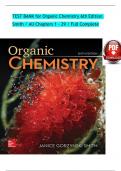TEST BANK for Organic Chemistry 6th Edition
Smith / All Chapters 1 - 29 / Full Complete
Page71
,Chapter 1 Structure and Bonding
7 7 7 7
Chapter 2 Acids and Bases
7 7 7 7
Chapter 3 Introduction to Organic Molecules and Functional Groups
7 7 7 7 7 7 7 7
Chapter 4 Alkanes
7 7
Chapter 5 Stereochemistry
7 7
Chapter 6 Understanding Organic Reactions
7 7 7 7
Chapter 7 Alkyl Halides and Nucleophilic Substitution
7 7 7 7 7 7
Chapter 8 Alkyl Halides and Elimination Reactions
7 7 7 7 7 7
Chapter 9 Alcohols, Ethers, and Related Compounds
7 7 7 7 7 7
Chapter 10 Alkenes and Addition Reactions
7 7 7 7 7
Chapter 11 Alkynes and Synthesis
7 7 7 7
Chapter 12 Oxidation and Reduction
7 7 7 7
Spectroscopy A Mass Spectrometry
7 7 7
Spectroscopy B Infrared Spectroscopy
7 7 7
Spectroscopy C Nuclear Magnetic Resonance Spectroscopy
7 7 7 7 7
Chapter 13 Radical Reactions
7 7 7
Chapter 14 Conjugation, Resonance, and Dienes
7 7 7 7 7
Chapter 15 Benzene and Aromatic Compounds
7 7 7 7 7
Chapter 16 Reactions of Aromatic Compounds
7 7 7 7 7
Chapter 17 Introduction to Carbonyl Chemistry: Organometallic Reagents; Oxid
7 7 7 7 7 7 7 7
ation and Reduction
7 7
Chapter 18 Aldehydes and Ketones—Nucleophilic Addition
7 7 7 7 7
Chapter 19 Carboxylic Acids and Nitriles
7 7 7 7 7
Chapter 20 Carboxylic Acids and Their Derivatives-
7 7 7 7 7 7
Nucleophilic Acyl Substitution
7 7 7
Chapter 21 Substitution Reactions of Carbonyl Compounds at the α-Carbon
7 7 7 7 7 7 7 7 7
Chapter 22 Carbonyl Condensation Reactions
7 7 7 7
Chapter 23 Amines
7 7
Chapter 24 Carbon-Carbon Bond-Forming Reactions in Organic Synthesis
7 7 7 7 7 7 7
Chapter 25 Pericyclic Reactions
7 7 7
Chapter 26 Carbohydrates
7 7
Chapter 27 Amino Acids and Proteins
7 7 7 7 7
Chapter 28 Synthetic Polymers
7 7 7
Chapter 29 Lipids (Available online)
7 7 7 7
Page72
, Chapter 1: Structure and Bonding
7 7 7 7
1. What7is7the7ground-
state7electronic7configuration7of7a7carbon7atom?7A)7 1s2,72s2,72p5
B)7 1s2,72s2,72p2 C)7 1s2,72s2,72p6 D)7 1s2,72s2,72p4
2. What7is7the7ground-
state7electronic7configuration7of7a7fluorine7atom?7A)7 1s2,72s2,72p2
B)7 1s2,72s2,72p3 C)7 1s2,72s2,72p4 D)7 1s2,72s2,72p5
3. What7is7the7ground-
state7electronic7configuration7of7a7magnesium7cation7(Mg2+)?7A) 1s2,72s2,72p6
C) 1s2,72s2,72p6,73s2
B) 1s2,72s2,72p6,73s1 D) 1s2,72s2,72p6,73s2,73p2
4. What7is7the7ground-state7electronic7configuration7of7a7chlorine7anion7(Cl—
)?7A) 1s2,72s2,72p6 C) 1s2,72s2,72p6,73s2,73p5
B) 1s2,72s2,72p6,73s2,73p6 D) 1s2,72s2,72p6,73s2,73p4
5. Which7of7the7following7statements7about7valence7electrons7is7true?
A) They7are7the7most7tightly7held7electrons.
B) They7do7not7participate7in7chemical7reactions.
Page73
, Chapter71:7Structure7and7Bonding
C) They7are7the7outermost7electrons.
D) They7reveal7the7period7number7of7a7second-row7element.
6. Which7of7the7following7statements7about7bonding7is7true?
A) Covalent7bonds7result7from7the7transfer7of7electrons7from7one7element7to7another.
B) Ionic7bonds7result7from7the7transfer7of7electrons7from7a7metal7to7a7non-metal.
C) Ionic7bonds7result7from7the7sharing7of7electrons7between7two7non-metals.
D) Covalent7bonds7result7from7the7sharing7of7electrons7between7two7metals.
7. Which7of7the7following7would7you7expect7to7have7ionic7bonds?
A) CO B)7 FBr C)7 NF3 D)7 NaCl
8. Which7of7the7following7molecules7has7nonpolar7covalent7bonds?
A) HCl B)7 N2 C)7 CHCl3 D)7 NO
9. Which7of7the7following7molecules7contain7both7covalent7and7ionic7bonds?
A) I,7II B)7 I,7IV C)7 II,7III D)7II,7IV
10. Arrange7the7following7bonds7in7decreasing7order7of7ionic7character,7putting7the7most7i
onic7first.
A) I7>7II7>7III7>7IV C) IV7>7III7>7II7>7I
B) IV7>7II7>7I7>7III D) IV7>7II7>7III7>7I
11. Which7of7the7following7statements7correctly7describes7the7typical7number7of7bonds7for7c
arbon,7nitrogen,7and7oxygen7in7most7neutral7organic7molecules?
A) Carbon7forms747covalent7bonds,7nitrogen7forms727covalent7bonds7and7oxygen7forms73
7covalent7bonds.
B) Carbon7forms747covalent7bonds,7nitrogen7forms737covalent7bonds7and7oxygen7forms72
7covalent7bonds.
Page74






